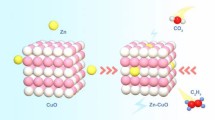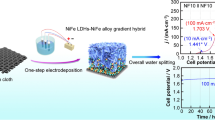Abstract
The rational design and facile construction of non-noble metal-based electrocatalysts for efficient oxygen reduction reaction (ORR) remain a challenge for the development of clean energy conversion devices. Herein, we synthesized a new type of hierarchical hollow carbon nanomaterials through one-step pyrolysis on bimetallic ZIF-Zn/Co precursors. The obtained hollow N-doped carbon composites, denoted as HNCT-CNTs, are enriched with Co-Nx sites and in-situ formed multi-walled carbon nanotubes (CNTs). Theoretical and experimental studies confirmed that the obtained HNCT-CNT exhibits excellent ORR catalytic activity with a reduced energy barrier for ORR intermediates. Owing to these advantages, the optimal catalyst shows an excellent half-wave potential of 0.85 V, a limiting current density up to 6.36 mA cm−2, a Tafel slope of 58.2 mV dec−1, and robust stability. Furthermore, the assembled Zn-air battery based on HNCT-CNT also displays an open circuit voltage of 1.49 V and a satisfactory power density of 116.56 mW cm−2. This template-directed preparation method opens up an interesting and efficient route to fabricate highly active non-noble metal-doped carbon nanomaterials for a wide range of electrochemical energy applications.

摘要
设计和制备用于高效氧还原反应(ORR)的非贵金属基电催化剂对于清洁能源转换装置的开发至关重要, 但又极具挑战性. 在本工作中,我们通过热解双金属前驱体ZIF-Zn/Co, 成功制备了一种新型的分级中空碳纳米复合材料HNCT-CNT. 该材料富含Co-N x 位点以及原位形成的多壁碳纳米管. 理论和实验表明, HNCT-CNT使ORR中间体的活化能垒降低, 因而表现出了优异的ORR性能. 最佳催化剂表现出较正的半波电位为0.85 V, 极限电流密度高达6.36 mA cm−2, Tafel斜率为58.2 mV dec−1, 且结构稳定性良好. 此外, 基于HNCT-CNT组装的锌空气电池还显示出1.49 V的开路电压和116.56 mW cm−2的功率密度. 综上, 这种无机物模板法为制备金属有机框架化合物衍生的非贵金属基碳纳米电催化剂用于高效的电化学能源领域提供了一种新的方法.
Similar content being viewed by others
References
Chung HT, Cullen DA, Higgins D, et al. Direct atomic-level insight into the active sites of a high-performance PGM-free ORR catalyst. Science, 2017, 357: 479–484
Du D, Zhao S, Zhu Z, et al. Photo-excited oxygen reduction and oxygen evolution reactions enable a high-performance Zn-air battery. Angew Chem Int Ed, 2020, 59: 18140–18144
Prabhu P, Jose V, Lee JM. Design strategies for development of TMD-based heterostructures in electrochemical energy systems. Matter, 2020, 2: 526–553
Yang X, Zheng X, Li H, et al. Non-noble-metal catalyst and Zn/graphene film for low-cost and ultra-long-durability solid-state Zn-air batteries in harsh electrolytes. Adv Funct Mater, 2022, 32: 2200397
Xu X, Pan Y, Zhong Y, et al. New undisputed evidence and strategy for enhanced lattice-oxygen participation of perovskite electrocatalyst through cation deficiency manipulation. Adv Sci, 2022, 9: 2200530
Farahani FS, Rahmanifar MS, Noori A, et al. Trilayer metal-organic frameworks as multifunctional electrocatalysts for energy conversion and storage applications. J Am Chem Soc, 2022, 144: 3411–3428
Chen K, Liu K, An P, et al. Iron phthalocyanine with coordination induced electronic localization to boost oxygen reduction reaction. Nat Commun, 2020, 11: 4173
Fan M, Yuan Q, Zhao Y, et al. A facile “double-catalysts” approach to directionally fabricate pyridinic N-B-pair-doped crystal graphene nanoribbons/amorphous carbon hybrid electrocatalysts for efficient oxygen reduction reaction. Adv Mater, 2022, 34: 2107040
Al-Zoubi T, Zhou Y, Yin X, et al. Preparation of nonprecious metal electrocatalysts for the reduction of oxygen using a low-temperature sacrificial metal. J Am Chem Soc, 2020, 142: 5477–5481
Wang X, Jia Y, Mao X, et al. Edge-rich Fe-N4 active sites in defective carbon for oxygen reduction catalysis. Adv Mater, 2020, 32: 2000966
Zhao KM, Liu S, Li YY, et al. Insight into the mechanism of axial ligands regulating the catalytic activity of Fe-N4 sites for oxygen reduction reaction. Adv Energy Mater, 2022, 12: 2103588
He Y, Shi Q, Shan W, et al. Dynamically unveiling metal-nitrogen coordination during thermal activation to design high-efficient atomically dispersed CoN4 active sites. Angew Chem Int Ed, 2021, 60: 9516–9526
Zhang J, Zhang J, He F, et al. Defect and doping co-engineered non-metal nanocarbon ORR electrocatalyst. Nano-Micro Lett, 2021, 13: 65
Lin L, Miao N, Wallace GG, et al. Engineering carbon materials for electrochemical oxygen reduction reactions. Adv Energy Mater, 2021, 11: 2100695
Hong Y, Li L, Huang B, et al. Molecular control of carbon-based oxygen reduction electrocatalysts through metal macrocyclic complexes functionalization. Adv Energy Mater, 2021, 11: 2100866
Jiang H, Gu J, Zheng X, et al. Defect-rich and ultrathin N doped carbon nanosheets as advanced trifunctional metal-free electrocatalysts for the ORR, OER and HER. Energy Environ Sci, 2019, 12: 322–333
Feng X, Bai Y, Liu M, et al. Untangling the respective effects of heteroatom-doped carbon materials in batteries, supercapacitors and the ORR to design high performance materials. Energy Environ Sci, 2021, 14: 2036–2089
Liu R, von Malotki C, Arnold L, et al. Triangular trinuclear metal-N4 complexes with high electrocatalytic activity for oxygen reduction. J Am Chem Soc, 2011, 133: 10372–10375
Li Y, Zhang P, Wan L, et al. A general carboxylate-assisted approach to boost the ORR performance of ZIF-derived Fe/N/C catalysts for proton exchange membrane fuel cells. Adv Funct Mater, 2021, 31: 2009645
Yang M, Zhang CH, Li NW, et al. Design and synthesis of hollow nanostructures for electrochemical water splitting. Adv Sci, 2022, 9: 2105135
Ding H, Wang P, Su C, et al. Epitaxial growth of ultrathin highly crystalline Pt-Ni nanostructure on a metal carbide template for efficient oxygen reduction reaction. Adv Mater, 2022, 34: 2109188
Wang X, Chen Z, Han Z, et al. Manipulation of new married edge-adjacent Fe2N5 catalysts and identification of active species for oxygen reduction in wide pH range. Adv Funct Mater, 2022, 32: 2111835
Chai L, Hu Z, Wang X, et al. Fe7C3 nanoparticles with in situ grown CNT on nitrogen doped hollow carbon cube with greatly enhanced conductivity and ORR performance for alkaline fuel cell. Carbon, 2021, 174: 531–539
Liang Z, Guo H, Zhou G, et al. Metal-organic-framework-supported molecular electrocatalysis for the oxygen reduction reaction. Angew Chem Int Ed, 2021, 60: 8472–8476
Li Z, Song M, Zhu W, et al. MOF-derived hollow heterostructures for advanced electrocatalysis. Coord Chem Rev, 2021, 439: 213946
Daglar H, Gulbalkan HC, Avci G, et al. Effect of metal-organic framework (MOF) database selection on the assessment of gas storage and separation potentials of MOFs. Angew Chem Int Ed, 2021, 60: 7828–7837
Gao D, Chen JH, Fang S, et al. Simultaneous quantitative recognition of all purines including N6-methyladenine via the host-guest interactions on a Mn-MOF. Matter, 2021, 4: 1001–1016
Mallakpour S, Nikkhoo E, Hussain CM. Application of MOF materials as drug delivery systems for cancer therapy and dermal treatment. Coord Chem Rev, 2022, 451: 214262
Sun Q, Zhu K, Ji X, et al. MOF-derived three-dimensional ordered porous carbon nanomaterial for efficient alkaline zinc-air batteries. Sci China Mater, 2022, 65: 1453–1462
Lin SY, Xia LX, Cao Y, et al. Electronic regulation of ZnCo dual-atomic active sites entrapped in 1D@2D hierarchical N-doped carbon for efficient synergistic catalysis of oxygen reduction in Zn-air battery. Small, 2022, 18: 2107141
Yuan S, Zhang J, Hu L, et al. Decarboxylation-induced defects in MOF-derived single cobalt atom@carbon electrocatalysts for efficient oxygen reduction. Angew Chem Int Ed, 2021, 60: 21685–21690
Wang W, Yan H, Anand U, et al. Visualizing the conversion of metal-organic framework nanoparticles into hollow layered double hydroxide nanocages. J Am Chem Soc, 2021, 143: 1854–1862
Liu P, Gao S, Zhang G, et al. Hollow engineering to Co@N-doped carbon nanocages via synergistic protecting-etching strategy for ultrahigh microwave absorption. Adv Funct Mater, 2021, 31: 2102812
Wang Y, Deng Z, Huang J, et al. 2D Zr-Fc metal-organic frameworks with highly efficient anchoring and catalytic conversion ability towards polysulfides for advanced Li-S battery. Energy Storage Mater, 2021, 36: 466–477
Guo Y, Huang Q, Ding J, et al. Ultrasmall Mo2C in N-doped carbon material from bimetallic ZnMo-MOF for efficient hydrogen evolution. Int J Hydrogen Energy, 2021, 46: 2182–2190
Huang Q, Xu Y, Guo Y, et al. Highly graphitized N-doped carbon nanosheets from 2-dimensional coordination polymers for efficient metal-air batteries. Carbon, 2022, 188: 135–145
Lee MJ, Kwon HT, Jeong HK. High-flux zeolitic imidazolate framework membranes for propylene/propane separation by postsynthetic linker exchange. Angew Chem Int Ed, 2018, 57: 156–161
Yun Y, Sheng H, Bao K, et al. Design and remarkable efficiency of the robust sandwich cluster composite nanocatalysts ZIF-8@Au25@ZIF-67. J Am Chem Soc, 2020, 142: 4126–4130
Arafat Y, Azhar MR, Zhong Y, et al. Advances in zeolite imidazolate frameworks (ZIFs) derived bifunctional oxygen electrocatalysts and their application in zinc-air batteries. Adv Energy Mater, 2021, 11: 2100514
Wang X, Chai L, Ding J, et al. Chemical and morphological transformation of MOF-derived bimetallic phosphide for efficient oxygen evolution. Nano Energy, 2019, 62: 745–753
Chen N, Xiao TH, Luo Z, et al. Porous carbon nanowire array for surface-enhanced Raman spectroscopy. Nat Commun, 2020, 11: 4772
Zhao M, Liu H, Zhang H, et al. A pH-universal ORR catalyst with single-atom iron sites derived from a double-layer MOF for superior flexible quasi-solid-state rechargeable Zn-air batteries. Energy Environ Sci, 2021, 14: 6455–6463
Cheng Q, Yang L, Zou L, et al. Single cobalt atom and N codoped carbon nanofibers as highly durable electrocatalyst for oxygen reduction reaction. ACS Catal, 2017, 7: 6864–6871
Xu H, Jia H, Li H, et al. Dual carbon-hosted Co-N3 enabling unusual reaction pathway for efficient oxygen reduction reaction. Appl Catal B-Environ, 2021, 297: 120390
Jia Y, Xue Z, Yang J, et al. Tailoring the electronic structure of an atomically dispersed zinc electrocatalyst: Coordination environment regulation for high selectivity oxygen reduction. Angew Chem Intl Edit, 2022, 61: e202110838
Shi H, Dai TY, Wan WB, et al. Mo-/Co-N-C hybrid nanosheets oriented on hierarchical nanoporous Cu as versatile electrocatalysts for efficient water splitting. Adv Funct Mater, 2021, 31: 2102285
Liu X, Zhang G, Wang L, et al. Structural design strategy and active site regulation of high-efficient bifunctional oxygen reaction electrocatalysts for Zn-air battery. Small, 2021, 17: 2006766
Xiao MJ, Ma B, Zhang ZQ, et al. Carbon nano-onion encapsulated cobalt nanoparticles for oxygen reduction and lithium-ion batteries. J Mater Chem A, 2021, 9: 7227–7237
Acknowledgements
This work was supported by the National Natural Science Foundation of China (21601137), the Natural Science Foundation of Zhejiang Province (LQ16B010003), and the Basic Science and Technology Research Project of Wenzhou, Zhejiang Province (G20190007).
Author information
Authors and Affiliations
Contributions
Qian J conceived the idea and supervised the project. Sun Q contributed to the experiments. Chen D conducted the DFT calculations. The paper was primarily written by Qian J and Sun Q. All authors contributed to the general discussion.
Corresponding author
Additional information
Conflict of interest
The authors declare that they have no conflict of interest.
Supplementary information
Experimental details and supporting data are available in the online version of the paper.
Qiuhong Sun received her bachelor’s degree from Wenzhou University in 2020, and now she is a graduate student at Wenzhou University. Her current research focuses on the design and synthesis of MOF-derived hierarchically porous materials with silica and oxide templates for electrochemical applications.
Jinjie Qian is an associate professor at the College of Chemistry and Materials Engineering, Wenzhou University. He received his PhD degree from Fujian Institute of Research on the Structure, Chinese Academy of Sciences, under the guidance of Prof. Maochun Hong. His current research is mainly involved in the electrochemical research on the carbon nanomaterials from metal-organic frameworks for energy storage and conversion.
Supporting Information
Rights and permissions
About this article
Cite this article
Sun, Q., Chen, D., Huang, Q. et al. Carbon nanotubes anchored onto hollow carbon for efficient oxygen reduction. Sci. China Mater. 66, 641–650 (2023). https://doi.org/10.1007/s40843-022-2173-3
Received:
Accepted:
Published:
Issue Date:
DOI: https://doi.org/10.1007/s40843-022-2173-3




